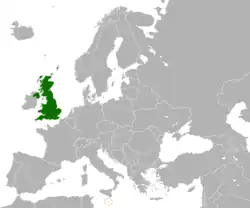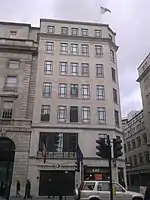Malta–United Kingdom relations
Malta–United Kingdom relations are foreign relations between Malta and the United Kingdom. The two countries share membership in the Commonwealth of Nations and the European Union up till 31 January 2020 when the UK withdrew from the bloc.
 | |
United Kingdom |
Malta |
|---|---|
History
The British took possession of Malta in 1800, defeating an unpopular French garrison that had taken possession of the islands two years earlier. Malta remained under British control until the end of the Treaty of Paris of 1814. The islands were seen as being of key strategic significance, lying between Gibraltar and the Suez Canal, and became an important shipping station on the sea route between Great Britain and British India. As a result, Malta became the headquarters of the British Mediterranean Fleet until the 1930s.
The islands were essentially under British military rule until 1849, when a partly elected legislative council was formed. In 1921, this was replaced with a fully elected bicameral parliament, which brought Malta a degree of Home Rule within the British Empire.
During World War II, the islands were regularly bombed by Axis forces. Despite the efforts of the Regia Aeronautica and the Luftwaffe, the islands did not surrender.[1] This is credited to the heroism of the general population of Malta, who earned them a collective George Cross, awarded by George VI in 1943. A depiction of the distinguished medal has remained on the Maltese flag to the present day (in a red fimbriation after its original blue canton was removed in 1964).[2]
In the 1950s and 1960s, serious consideration was given in the United Kingdom and Malta to the idea of a political union between the two countries. Despite Malta supporting integration in a 1956 referendum, the plans for it foundered, and Malta gained its independence from the United Kingdom in 1964. The British monarch Queen Elizabeth II remained Queen of Malta until the country became a republic in 1974.
After independence, a defence agreement, coupled with a financial aid package, allowed the continued use of Malta by British armed forces and the island was the Mediterranean headquarters of NATO.[3] In 1971, the new prime minister of Malta, Dom Mintoff, cancelled the agreement resulting in the withdrawal of British forces, but in March 1972, a further agreement was reached at Marlborough House in London, for the use of British bases on Malta for a further seven years.[4] All British forces finally withdrew on 31 March 1979, an event commemorated by the Freedom Day national holiday.[5]
There is a small Maltese community in the United Kingdom. In addition, the British overseas territory of Gibraltar has been influenced by significant immigration from Malta in the 18th and 19th century.
Since the Brexit referendum, the number of applications for Maltese citizenship by British citizens, based on either family link or long-term residence, has seen a spike from 382 in 2016 to 619 in 2017 and 704 only in the first 10 months of 2018.[6] Malta remains a popular tourist destination for British holidaymakers, with 640,570 arrivals from the United Kingdom in 2017.[7]
Resident diplomatic missions
- Malta has a high commission in London.
- United Kingdom has a high commission in Valletta.
 High Commission of Malta in London
High Commission of Malta in London High Commission of the United Kingdom in Valletta
High Commission of the United Kingdom in Valletta
See also
References
- "World War II". Visit Malta. Retrieved 2021-09-11.
- "The Story of Malta's George Cross and WWII". airmalta.com. Retrieved 2021-09-11.
- "The Malta Garrison – 1964". www.maltaramc.com. Retrieved 10 February 2022.
- "Britain and Malta Agree On Price for Use of Bases". New York Times. March 27, 1972. Retrieved 10 February 2022.
- "The way we were 1979". Times of Malta. Valetta. Retrieved 10 February 2022.
- Britons eye Maltese citizenship amid Brexit fears, Times of Malta, November 16, 2018
- Davies, Phil (6 June 2019). "UK tourists to Malta on the rise". travelweekly.co.uk. Jacobs Media Group. Retrieved 10 February 2022.
